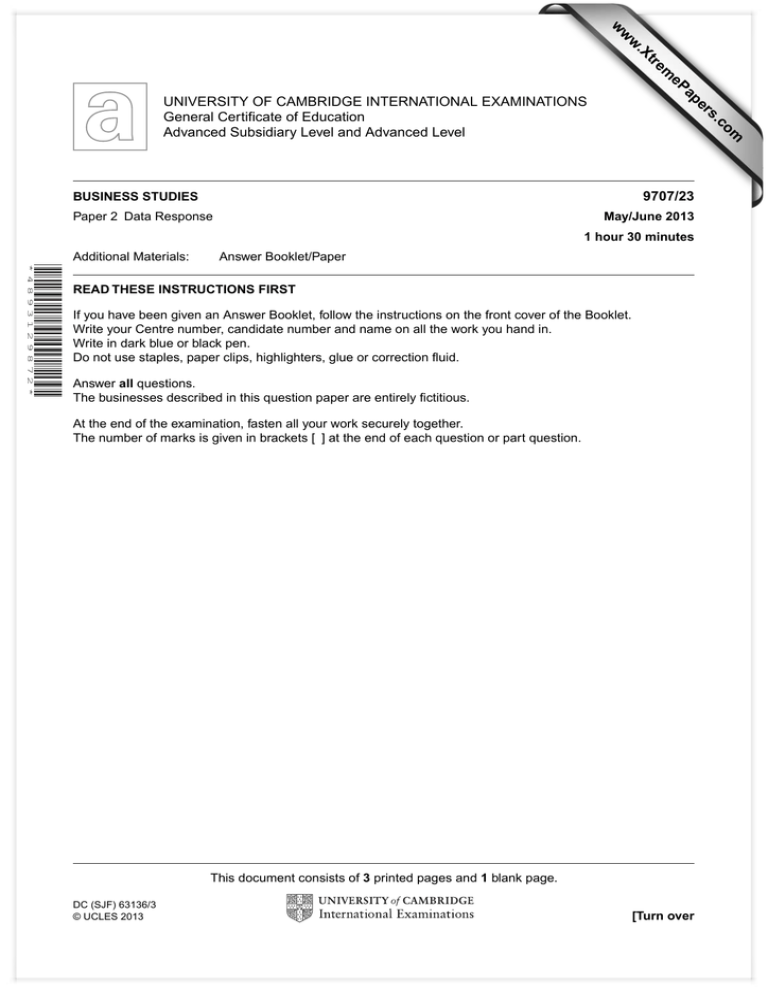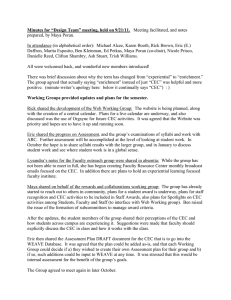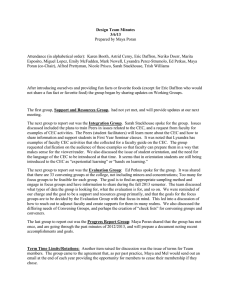www.XtremePapers.com
advertisement

w w ap eP m e tr .X w om .c s er UNIVERSITY OF CAMBRIDGE INTERNATIONAL EXAMINATIONS General Certificate of Education Advanced Subsidiary Level and Advanced Level 9707/23 BUSINESS STUDIES Paper 2 Data Response May/June 2013 1 hour 30 minutes Additional Materials: Answer Booklet/Paper * 4 8 9 3 1 2 9 8 7 2 * READ THESE INSTRUCTIONS FIRST If you have been given an Answer Booklet, follow the instructions on the front cover of the Booklet. Write your Centre number, candidate number and name on all the work you hand in. Write in dark blue or black pen. Do not use staples, paper clips, highlighters, glue or correction fluid. Answer all questions. The businesses described in this question paper are entirely fictitious. At the end of the examination, fasten all your work securely together. The number of marks is given in brackets [ ] at the end of each question or part question. This document consists of 3 printed pages and 1 blank page. DC (SJF) 63136/3 © UCLES 2013 [Turn over 2 1 Coffee Paradise (CP) Anna owns six coffee shops in different parts of the city. The business has benefited from internal growth over the past few years. Customers like the individual styles of CP’s shops compared with the standard designs of international competitors. Anna used to work in the fashion industry so she has very high standards for the appearance of her coffee shops. Anna has problems recruiting employees for the city centre shop. In the past she has relied on a recruitment agency. She tells the agency how many employees she needs and the agency selects the workers. She assumes that it is obvious what sort of people are needed to work in a coffee shop! However, some employees have not had the right skills or they have left the job after only a short time. Anna is now planning to do the recruitment and selection herself. She thinks that employees should be hard working, skilled at dealing with customers and reliable. 5 10 Customers at the city centre shop have asked whether CP could sell meals as well as coffee. Anna has made the cost estimates in Table 1. She noted that a competitor’s typical price for a meal is $2.60. Table 1: Cost estimates for meals Probable cost of ingredients $0.80 per meal Other direct costs $0.30 per meal 15 Anna’s business objective is to continue expanding over the next few years. Anna is investigating opening a new coffee shop. She is considering two possible sites. The information on the two sites is shown in Table 2. 20 Table 2: Possible sites for a new coffee shop Site A: Westville shopping centre New shopping centre outside of the city No other coffee shops Site B: Northtown International Airport Established airport A range of other shops for refreshments Available shop site not in ideal position Rents based on profits Very convenient for travellers Rents fixed, but quite high New shop that can be changed to Anna’s design Old shop that cannot be changed much 25 30 (a) Explain the following terms: (i) internal growth (line 2) [3] (ii) direct costs (line 17). [3] (b) (i) Assume CP uses a mark-up of 70% on costs for pricing its meals. Using the information in Table 1, calculate the price that CP would charge for its meals. [3] (ii) Explain one factor (other than mark-up) that Anna should consider when deciding on the price for meals. [3] (c) Analyse methods that Anna could use to improve the recruitment and selection process. [8] (d) Using Table 2, recommend to Anna the best site for the new coffee shop. Justify your answer. [10] © UCLES 2013 9707/23/M/J/13 3 2 Cando eCables (CeC) CeC is a large private limited company. CeC manufactures electric cables for a wide variety of uses. The products include very large cables for industrial uses such as in power stations and much smaller cables for connecting computers in consumer markets. Most cables are made of copper and those that are not use other valuable metals. Metal prices are subject to huge fluctuations in world markets. 5 Until 3 years ago CeC was very successful in achieving its growth objective of 10% per year. With the worldwide economic downturn seriously affecting many of its industrial customers, CeC has tried to reduce costs as much as possible with the aim of reducing prices. CeC’s objective has become survival. Jay, CeC’s Managing Director, is thinking about when will be a good time for CeC to change back to the growth objective. 10 Jon, the Marketing Director, was studying sales data following recent price reductions. Table 3: Impact of prices on demand for CeC’s products Product Price decrease (%) Increase in Demand (%) Industrial cables 10% 2% Computer cables 5% 20% Comments about the market Industry is in decline due to poor economic conditions 15 The information technology sector is growing and sales of home computers are increasing Falling sales of some products mean that inventories of industrial cables are higher than usual. However, inventories of computer cables are almost zero. The bank balance has fallen because CeC had to pay for unexpected repairs to some machinery. Suppliers have recently reduced their credit terms. These changes have had an impact on CeC’s cash flow. With a current ratio of 0.8 and an acid test ratio of 0.2, CeC has a serious liquidity problem. 20 (a) Explain the following terms: (i) consumer markets (line 3) [3] (ii) cash flow (line 23). [3] Using Table 3, calculate the price elasticity of demand for computer cables. [2] (b) (i) (ii) The price elasticity of demand for industrial cables is estimated to be –0.2. Using this information and your answer to (b)(i), briefly comment on the differences between the markets for CeC’s products. [4] (c) Analyse the need for CeC to review its objectives over time. (d) Discuss possible solutions to CeC’s working capital problems. © UCLES 2013 9707/23/M/J/13 [8] [10] 4 BLANK PAGE Permission to reproduce items where third-party owned material protected by copyright is included has been sought and cleared where possible. Every reasonable effort has been made by the publisher (UCLES) to trace copyright holders, but if any items requiring clearance have unwittingly been included, the publisher will be pleased to make amends at the earliest possible opportunity. University of Cambridge International Examinations is part of the Cambridge Assessment Group. Cambridge Assessment is the brand name of University of Cambridge Local Examinations Syndicate (UCLES), which is itself a department of the University of Cambridge. © UCLES 2013 9707/23/M/J/13



